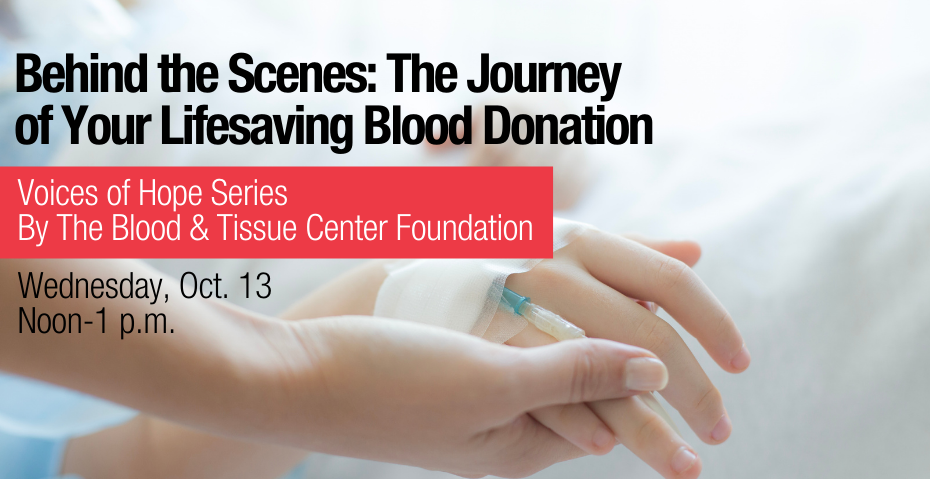Staff from South Texas Blood & Tissue Center, along with a blood donor and patient, showed the steps it takes to get a blood donation from donor to patient during a webinar sponsored by The Blood & Tissue Center Foundation on Wednesday, Oct. 13.
Guest speakers included Annette Henessey and her daughter Naomi. Annette is a committed blood donor who pays it forward because Naomi needs up to 40 blood transfusions a year for a rare blood disorder.
The installment of the Voices of Hope series was entitled “Behind the Scenes: The Journey of Your Lifesaving Blood Donation.”
Webinar Q&A
Q: Are you starting to see an increase in the number of donors compared to the prior 18 months as people return to a more normal daily life?
A: Not to the rate sufficient to provide for the increased needs of our community. Some high schools, colleges, universities, and employers have resumed blood drives with us, but we still need more to get back to a comfortable level. This week we are down under two days of supply across all blood types, with just a half-day supply of type O blood available. We are triaging orders and prioritizing distribution to the most critical needs.
Q: What happens if blood and tissue and/or other partners do not have the right blood type available for the current need?
A: Universal blood types are then leveraged (if available) to support the patient. For instance, if a patient is type B and needs a transfusion of red cells, but type B is not available, then type O donor blood can be used. The challenge is with a critically low inventory of the universal blood available, the blood can only be made available for the more critical needs and some transfusions may be delayed until more donors give blood.
Q: How do you triage where the blood products go when running low? Or is there a method for increasing donations during emergency situations?
A: We work with the healthcare team to prioritize the most critically ill patients for access to available blood. We also provide alerts to our donor community by text message, email, and phone call, as well as media posts to ask donors to come in and help when blood inventory is critically low to the point we have to triage blood orders. We don’t want anyone to not have access to the blood that is needed.
Q: Is it possible to come in for a tour?
A: Absolutely! We would love to provide a tour. Please contact Foundation@biobridgeglobal.org to schedule a group tour.
Q: If you can’t give blood, how can you help?
A: Financial contributions are always needed to support our operation and outreach to donors. We know that’s not always possible for everyone but one way anyone can help for free is by sharing the need for blood with people in your network, encouraging friends, family, and colleagues to donate frequently. You can also work with us to host a blood drive with your community. Just reach out to us at SouthTexasBlood.org
Q: Do most first time donors become regular donors? I would expect many are very nervous to give. How are we able to get them to come in on a regular basis?
A: Having donors come back consistently to give more than once each year is the key to ending the blood shortage. We work hard to make the process as fast, comfortable, and easy as possible, but we always want to improve as well. The donor experience is so important. The donor needs to feel valued, cared for, and reminded about why they are uniquely qualified to be a blood donor.
Q: How are you finding the donors for the blood for the Brothers in Arms program?
A: We screen healthy donors who are Type O for the absence of HLA markers (special antigens), and then ask if they would like to enroll in our program called Brothers in Arms (BIA). We need these donors to come in as frequently as possible as they can provide a rare gift to ensure those experiencing trauma can get the blood they need to make it to the hospital and into surgery. The program has already saved hundreds of lives over the past 2 years.
Q: Are there uses for research for donations of blood that might not be able to be used for transfusions?
A: Yes, we work in collaboration with researchers to study new test methods, processing, and storage methods so that all gifts are used in a way that advances the ability of blood to save and enhance lives. It’s core to our mission, vision, and values as an organization. We may even ask donors to participate in new research programs to study new therapeutic uses for their donation. Sometimes, these donors can receive reimbursement for their time to participate as research program donors. More information can be found here.
Q: Do you have a frozen red cell supply in San Antonio? Is that still seen as a viable backup for low supply issues?
A: We have the capability to pivot manufacturing to freeze red cells when we have additional blood available above the current demand. The frozen red blood cells do take time to thaw and prepare for transfusion so are not greatly suited for emergency situations but it is an option we can and do leverage for continuity.


